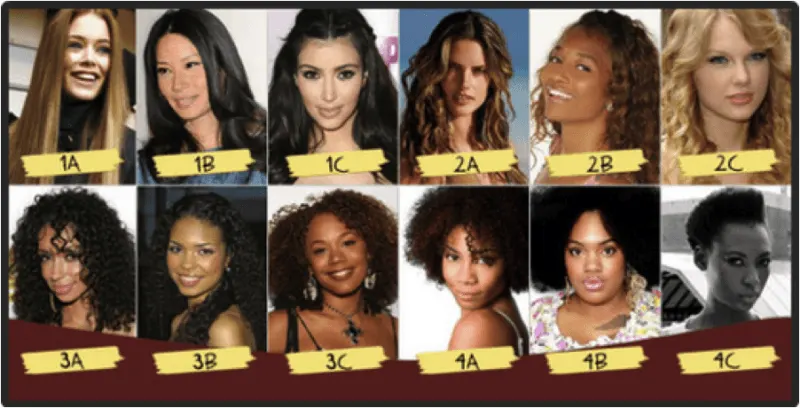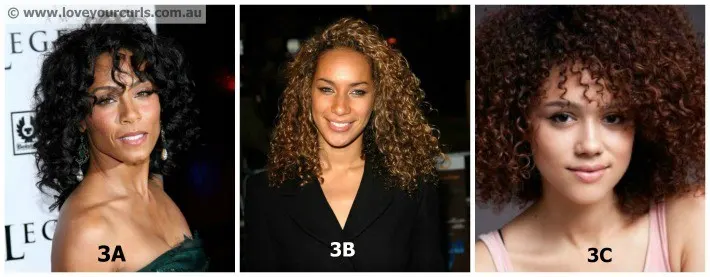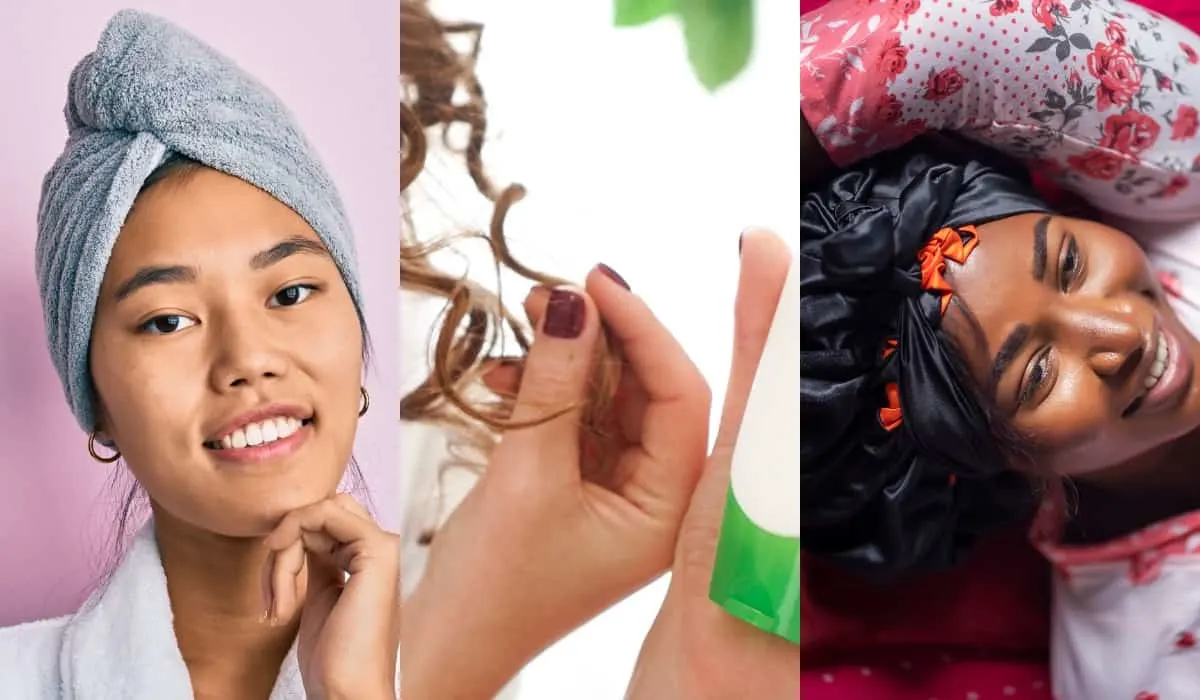Curly hair is definitely on the rise again, steadily gaining popularity within the past decade. The internet has allowed other women with curly hair to share the methods and regimens that they use when wearing their hair in its natural state.
This surge of information has driven a host of women from all backgrounds to begin caring for their hair the correct way, as opposed to trying to treat it as if it were straight.
Unbeknownst to many, there are 3 different types of curly hair– loose curls, ringlet curls and tight kinks and coils. Although they are all categorized as being ‘curly’ hair, they all have different needs in terms of products and maintenance.

Different Hair Types for Curly Hair
Here’s what you need to know about the different types of naturally curly hair. Find in which one your hair falls so that you can take care of it accordingly.
Type 2

Type 2 hair is classified as more of a wavy hair texture with a variety of loose curls. Type 2a hair is wavy with no actual ‘curl pattern,’ type 2b is a mixture of wavy and loose curls (otherwise known as beach waves), and type 2c hair has loose curls.
Since Type 2 hair is relatively straight, it can pretty much be treated as such. A light mousse can be added in order to encourage the hair to curl, but make sure you don’t use too much in order to avoid making the hair crunchy. Follow up with a light serum in order to lock in moisture and prevent frizz.
This curl type might not be wavy from root to tip. You might have straight hair towards the roots and wavy in the mid-lengths. The ends might be frizzy with heat damage and the whole length of your hair might lose some of its waves if it gets too dry.
Type 3

Type 3 hair is classified as having a variety of large, corkscrew/ringlet curls. Type 3a hair is an “S” curl described as having the circumference of the width of sidewalk chalk.
Type 3b hair is a bit coarser and is described as having the circumference of a Sharpie marker. Type 3c hair is the coarsest of type 3 hair, with the circumference of a pencil.
Type 3a hair can be cleaned daily, but only with a cleansing conditioner. This hair should be styled with mousse using the rake and shake method and followed up with a serum or pomade.
Type 3b needs to be handled a little more delicately than 3a. This hair should be moisturized daily but does not need to be cleaned daily in order to preserve the hair’s natural oils.
Type 3b hair should use a lightweight leave-in and be styled with styling milk or cream in order to encourage clumping.
Follow up with a lightweight oil/serum in order to lock the moisture into the hair and prevent frizz. Deep condition this hair once a week in order to keep the hair healthy and moisturized.
Type 3c can handle thicker products, which is beneficial in keeping this hair moisturized. This hair should pretty much be handled the same way type 3b hair is, but heavier products may be needed.
Instead of using the leave-in spray or hair milk, opt for a creamy leave-in that’s still lightweight. Rod sets can give this hair a more uniform look, but they are not needed. Deep condition this hair once a week in order to keep the hair healthy and moisturized.
For whatever reason, the tighter your Type 3 curls are, the drier they will be. It’s easy for them to lose definition without the proper hydration routine. You might end up with a dense ball of fuzz, so make sure to use products that provide intense moisture.
Type 4

Type 4 hair is the most fragile hair since it is the curliest. It’s also classified as the driest since the scalp’s natural oils cannot extend down the entire hair shaft. Type 4 hair is also very fine even though it’s coarse and dense.
Type 4a has an “S” curl type of pattern and is one of the most distinguishable curl patterns within the type 4 category. This hair type can also get relatively coily. The shrinkage for this hair type can range anywhere from 50-70% of the hair’s actual length.
Type 4b has a “Z” curl type of pattern and is less defined than 4a. This hair doesn’t curl or coil and tends to be pretty dry and densely packed. The shrinkage that this hair type experience is up to 75%.
Type 4c has no definitive curl pattern. It doesn’t clump and is usually densely packed and wiry. This hair type experiences the most shrinkage out of all the curly hair types, shrinking over 75% of its actual length.
Since this hair type tends to be dry, it should be deep conditioned weekly with a thick conditioner. It’s also important to moisturize the hair multiple times a week using either a thick leave-in conditioner or a leave-in spray as a refresher.
This hair should be cleaned with a moisturizing conditioner and should ONLY be detangled with a wide-tooth comb while the hair is saturated with a conditioner or detangler. The LOC (leave-in, oil, cream) or LCO method also works great with this hair type in terms of locking in moisture.
How to Identify Your Curl Pattern

Because most people have more than one curl pattern on one head, it’s a good idea to choose a few hairs from the curliest area of your head and perform a test. Start with wet hair and pluck a few hairs.
Place them on a white sheet of paper and identify first: are they wavy, ringlet curly or coily? It helps to know at this stage what are the boundaries between wavy, curly and coily, and that’s actually pretty easy.
Let’s start with the middle curl, Type 3 curls. These curls are uniform ringlets, whether they are type a, b or c. Do your hairs make a uniform curl like they are wrapped around a long, straight object like a pencil.
If so, your hair is Type 3. If the curl is looser, you have wavy, Type 2 hair. If your hair wraps around in a curl and then changes direction and wraps in another curl, you have Type 4, coily hair.
From here, you can follow the tips above to see if you have a, b or c curls. But, here’s the thing, most people might have a variety of curl types on their head, but usually they have overall wavy, curly or coily hair. It just might be a mix of a, b and c.
So with the few strands you’ve chosen, go to a section of your hair with a looser curl and pull a few strands. You’ll see they probably look just like the first few strands but are looser in structure.
So you could say that the first strands are c curls and the second grouping are b curls. If you have an even looser section, they are curls.
Hair Damage, Hair Products, and Hair Typing
Ideally, your hair will be virgin, clean and free of all products before you attempt to discover your hair type. Also, it should be free of heat damage, if possible. Heat can stretch the proteins in the hair irreversibly, leading to limp hair that has a straighter curl pattern.
Chemicals like hair dye can alter the protein bonds in the hair and make it less curly. So if you have products in your hair like conditioner or mousse, or chemicals like dye, or if you use heat every day, it will be difficult to determine your actual hair type.
And because chemicals and heat work on the hair follicles too, it might be a few months before your real texture comes in, should you decide to cut your hair.
Keeping Your Natural Curl Type

Because the cosmetic industry is poorly regulated, it’s better for your health, in the long run, if you keep your tresses natural. Sometimes we don’t find this out until we start losing our hair or it turns fine in texture as a prelude to hair loss.
Embracing your natural hair type doesn’t mean you won’t look presentable or sleek. There are many ways to style natural hair and define your curls or lay them flat without chemicals.
The most amazing hair feats can be accomplished with plopping and curl-defining products, or if you want to lay it down, with a spritz of water and a scarf worn overnight.
Experiment with your natural hair and see what can be accomplished. Once you learn your hair’s behavior, you might be surprised with all the beautiful, natural looks you can style it into.
FAQs
There are actually 9 types: 2a, 2b, 2c, 3a, 3b, 3c, 4a, 4b and 4c.
If your curl circumference when your hair is wet is about the diameter of a pencil, you have 3c hair. If it is more like a Sharpie marker, it is 3b.
Type 2a hair is plain way hair, but 2b has a mixture of waves and loose curls.
All type 3 curls are ringlets of different sizes. Type 2c curls are not ringlets, but regular curls.
Yes.
Type 4 curls are all coils. Type 4c is the most tightly coiled hair.
Whether you’re dealing with type 2, 3 or 4, C curls are the “most.” So type 2c is the waviest, type 3c is the most ringletted and 4C is the most coily.
3C curls are tight ringlets that have the diameter of a pencil. 4A hair doesn’t have ringlets but is more of a loose coil.
When wet, very small sections of hair might form a ringlet that has spaces in between, but these ringlets will not be uniform, won’t be across the entire head, and won’t be as large as a pencil, but very small.
It doesn’t exist.
Curly hair is genetic and has to do with the shape of the hair follicle and the spacing of the protein bonds within the hair.
Try the tips in this article. But keep in mind that every head of hair is different, so there will be some trial and error.
You May Also Like
